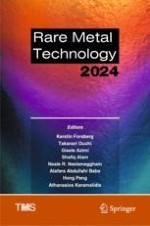2024 | OriginalPaper | Chapter
Bioleaching of Post-consumer LiCoO2 Batteries Using Aspergillus Niger
Authors : Sadia Ilyas, Rajiv Ranjan Srivastava, Hyunjung Kim
Published in: Rare Metal Technology 2024
Publisher: Springer Nature Switzerland
Activate our intelligent search to find suitable subject content or patents.
Select sections of text to find matching patents with Artificial Intelligence. powered by
Select sections of text to find additional relevant content using AI-assisted search. powered by
